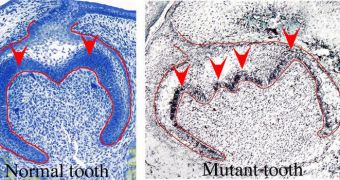A team of Swiss researchers from the University of Zürich announces the discovery of a new gene that is apparently involved in the tooth formation (odontogenesis) process. In a new paper, the researchers explain how inactivating the gene called Jagged2 can result in the developed organism featuring teeth that have both malformed crowns, and also no enamel whatsoever. The finding may be very important for medicine, as it may inform new researchers in treating genetic tooth malformations in the near future, AlphaGalileo reports.
The gene acts on the Notch signaling pathway, the team says, which means that if the gene is not expressed, this pathway is interrupted. The thing is that Notch is involved in the formation of almost all other tissues and organs, which means that the discovery may hold the key to explaining some of the most mysterious medical conditions, at the very least. The Swiss group mentions in the new paper that signaling pathways play a crucial role in the human body. They are responsible for allowing cells to react in response to stimuli from their environment, which is one of the most important traits defining life. The processes of adaptation and evolution are tightly related to this ability.
According to University of Zürich professor of oral biology Thimios Mitsiadis, the Jagged2 gene proved essential for tooth formation in unsuspecting lab mice. The rodents were subjected to genetic manipulation, and the expression of this particular gene was inhibited. Consequences included the development of more cusps, severe deformations of molars' crowns, and lack of cell growth and enamel in incisors. When the gene is not expressed, the team leader says, the Notch pathway is interrupted. When this happens, the formation and differentiation of neighboring tissues become nearly impossible.
This is another of the Notch pathway's main effects. The signals it carries allow for cells located in close vicinity to each other to develop into different tissues. For example, the last layer of liver cells and the first layer of support tissue around the organ differentiated from each other to fulfill different functions via the actions of the Notch pathway. This explains why the various tissues in the teeth of lab mice failed to develop properly, the investigators say.

 14 DAY TRIAL //
14 DAY TRIAL //